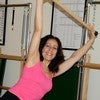Description
About This Video
Transcript
Read Full Transcript
Welcome to Pilates Anytime. I'm Elizabeth Larkam, thrilled and delighted, honored to be with Kristi Cooper. Pleasure's all mine. (laughs) a little nervous. We're bringing you our first level of variable intensity interval training, using the Pilates.
We'll be alternating the elastic recoil jumping sequences with some trunk and core control. Here we go. Kristi promised me that anytime she has a comment, she's speaking up. And I said, can't wait. (laughs) I'm gonna remember that.
Let's start on the supine with a red spring on the heavy setting. So you have enough compression to keep you from flying off the board. Thank you. Your headrest is up. And come to lie on your back.
Lying on your back, push back and bring your heels to the very bottom of the foot plate. Place the pads of your fingers between pubic bone and naval. So that you can feel the connection between your feed and your abdominals. Now, pressing the pads of your toes down, lift up your metatarsals and then glide your heels forward. So it feels like this doming on parade, could take a half a century.
But as you get going, you will appreciate, she said, unabashedly leading the witness.
Sometime this afternoon. That's right. Now...
Bend, press of your toes and drive your heels back. So now you're going down the foot plate, in the direction of the floor.
And also, pick up the tempo now and go towards the top of the plate. The drawing your rear foot, your heel towards your toes, makes a stronger abdominal connection and when you reverse and pressing your toes to your heels, then it's more the back of your legs.
That's right, the question is, is this more for the feet an the abs? Or for the back of the brain? For me, the brain for sure. But I did feel the others. Fantastic.
Those other things. Let's change to a blue spring. A blue spring in a stronger setting now. And you'll come to all fours.
Here you are with your elbows bent and your forearms on the box. And your knees very close to the spring edge of the carriage. That's it, now Kristi, you can back your knees up a little bit more and bring your toes down a little bit lower to the very bottom of the upholstery of the foot plate. Now, as if your feet could strike a match, you'll brush the soles of your feet and draw your heels to your sitting bones. Sounds good from here.
(Kristi laughs) Keep going.
Hmm, right. This is perfectly reasonable form. However, it's not effective for elastic recoil. Because for elastic recoil, we have to get off the mat, off the jump board faster. Oh! Jump off! And jump so you spend a long time in the air.
How do you get back there so fast? I'm not striking. There we go. Right. Strike.
The abdominals jump to the spine, the feet get off the matchbox because it's hot. Twice more. Go Kristi, go! (laughing) It's hard to not just push rather than strike. Okay, I'm back. Well done.
Done with that. Great. Okay. So now, bring your box next to the reformer frame. Now facing the jump board, put your box to the right side of the carriage.
Take the spring off. No spring at all? No spring at all. Oh, boy. Hmm.
And then bend both elbows, put your forearms on the carriage. So here you are on all fours, two forearms, two elbows, and two knees. As you inhale, glide the carriage towards the risers, and keep on going until you get to the outside of your left knee. Exhale. Putting your left elbow towards your right knee, put your right knee down and hover your left knee shin foot.
Again. As you inhale, glide way over to the risers. Exhale to come home. Sitting bones up and wide. And hover your left knee.
I'm not rotating, am I? You are correct, you are not rotating, well, I mean, your pelvis rotates when you come onto your outside of your left knee. Then your chest bones stays right down between your forearms. Last one of these. It could be exhale to go out or inhale.
Either way, it's beneficial. Now, hover your left knee and put it down. Keep the carriage at home and swivel both feet to your right, towards the jump board. And relocate both hands to the far shoulder rest. So here you are, on all fours, on a diagonal.
As you exhale, slide the carriage towards the risers. You can reach your right leg our behind you. Exhale, come back. And hover you left knee shin foot. Okay...
Exhale to glide out. Inhale to come back. I love that leg extension. Oh, super. We should do two more, in that case.
Okay. Exhale... Which do you like better? Your heel reaching back or your toes reaching back? My heel.
Well, me too. Exhale, send your right heel way back behind you and come home. And hover your left knee shin foot. Now, swivel both feet to the left side, the left diagonal. Bring both hands to the far corner of the carriage near the springs.
As you exhale, slide the carriage towards the risers. And do you like a knee extension here? I do. I don't think I could do it otherwise. I was confused until you did the side kick thing.
You can throw attitude on that one. Oh, shall we? Here we go. A high side attitude, a parallel attitude. Yes! Yeah! (laughing)
That's right. Here we go. Out and... In and... And up.
That feels really good. I mean, I'm making fun. But that feels really good. Where do you notice it? The twist was hard on one side.
The confusing side, the second side, the second version. It just feels good. I just like stretching out and contracting. That's the human condition. Line up your box with the end of the carriage, which you have done.
And bring your forearms, your elbows, your hands onto the carriage. As you exhale, slide the carriage towards the risers. And here's that reach our through your heel, go, go, go. Exhale to come back. And hover up.
Right knee, shin, foot comes off. That's right, uh huh.
Inhale to come back. And hover. Two more of these. The exhalation on the way out and the inhalation on the way back is probably a good, last time of this, sort of a good breathing safety belt. Because we're going out with no springs.
So the exhalation will help keep us connected and collected. Now... Aim both feet towards the foot plate. And both hands towards the far shoulder rest. So now your whole axis, super, is on a diagonal.
Exhale to slide out. And here's the hip extension that you enjoyed. Wonderful. Come right on back. And aim your right PSIS towards the ceiling, the hovering.
Twice more. Exhale to slide. Inhale to come forth. Such a good proximal connection of ribs to pelvis. Last one of these because you have a ground force through your forearms and through your elbows.
Now swivel and face the new diagonal. So both hands come to the corner of the carriage, close to the foot plate. Exhale. And which do you prefer? The attitude or the parallel all sick on, we got that going on, good.
I did not bend my knee but I like it.
We've done three diagonals, three variations on each side. Let's leave the boxes right where they are. Put the red spring on and the red spring on in the higher setting. So you have enough spring compression to do some supine lying on your back, ankle jumps. For this, the headrest comes all the way up.
That's right, so there's a modicum of hip flexion. Now in this case, you're knees will not bend. Knees stay extended. And we do push ups for the feet. Jump, jump, jump, jump, jump, jump, jump.
Eight more. Jump, jump, drawing in right above your pubic bone, five and six and seven and eight, pause. Excellent. So here you are with your heels slightly closer to the ceiling than your sitting bones, your piscium, which puts you in a little bit of hip flexion. And now let's go as fast as we can, spend as much time in the air and less time on the ground.
Ready, go!
We have a second round of this, in which instead of staying in parallel, you'll keep your pelvis level and steady, the usual Pilates right behavior. And then you'll aim both heels to one side and all toes to the other. And you'll jump form there and then land there. So you do your windshield wiper jumping. Lots of tone in these cheeks.
You got that going on. Alright, this time... You say go.
Eight more, Kristi, go! Hang time in the air.
Let's keep the box on its current side and just place the box so that it's in the center of the shoulder rest. So the box just slides a little bit closer to the risers. Great. So now, Kristi, you'll be on your shins, on your knees, with your left hand on the close shoulder rest. Like that.
And your right hand on the far shoulder rest, like that. Both elbows--
And the light from your chest bone is going right down to the space between the headrest and the carriage. This is rotation. So you slide the carriage to the risers and take a nose dive right on down to the carriage. Left had is pulling, right hand is pushing.
And come right back up. Do this once again each way. Your nose goes down, left hand pulls, right and pushes.
Where does it feel good?
Hmm. Keeping your hands, your body where it is, flip both feet, swivel both feet to your left. So your feet go on it like that, mmhmm. Now, keeping your arms where they are, bring your whole body in line with your feet. So now your torso is on a long diagonal towards the riser end, like that.
As you exhale, slide the carriage, pulling with your left hand, pushing with your right hand. Sitting bones lead up and back behind you. Exhale to come back in. This time, as you inhale, your ear listens to the carriage. And you look towards your right hand on the top of the shoulder rest.
And come back in. Once again, each way. Aim your eyes and your nose directly down to the carriage. Left hand pulls, right hand pushes. And come back in.
Then your head, neck and eyes follow your right hand, which is pushing away. And come back. Keeping your hands, your torso, where it is, flip both feet towards your right side. And this time we're going to take a little different. Bend your left knee and put your left foot on the carriage.
You did what I said, indicating that I did not say what I meant. That would be really wild if the left foot was on the carriage. My mistake.
Me too. I was bewildered. Bring the carriage all the way home for the moment. There we go. Okay.
Now... Aiming your sitting bones up and back behind you, take a nose dive directly down to the carriage, pulling with your left hand and pushing with your right.
Except maybe more so. And come back in. Now turning your ribs, shoulder, head, neck and eyes, your left ear listens to the carriage and you look at your right hand on top of the shoulder rest. And come back in. And just because this is so unusual, we're going to do two more rounds of it.
Nose dive down. The left side of your ribs hugs your left inner thigh. And come back in. Now your turn your head, neck, and eyes to follow your right hand. And your left lung still hugs your left inner thigh.
Last round, last two of each of these nose dive and ear dive. Which do you prefer, to exhale going forward or to inhale going forward?
That's good, this time I'll come through the narrows here. Now when the carriage is home, the box goes directly in the center of the shoulder rest axis. Come to you knees, come to your shins. Now your right hand, which is closet to the foot plate, comes onto the shoulder rest close to you. And your left fingers point over the frame.
Bring your sternum, so your aiming the light from your chest bone, between the shoulder rest and here we go. Take a nose dive straight down, right hand pulls, left hand pushes. Sitting bones go up and back behind you. And come back in. Now turning head, neck, and eyes, so you can look at your left hand on the shoulder rest and your right ear listens to the carriage.
One more of each of these. It could be inhale here, exhale to come in. Or it could be exhale here.
Now, swivel both... Where did we go first? Both feet towards the foot plate so your head is aiming towards the riser in. It won't actually go to the risers but it will go in that direction. And then bring your body so your thorax is in line with your pelvis there.
As you breath, the carriage slides. Pulling with your right hand, pushing with your left.
But also because of your pulling and pushing as you should on the shoulder rests. There's some compression for the shoulder joint, which is oftentimes welcome.
Which is the one closest to my knees.
So your right foot's on the box. See, I learned. I learned that, don't put the right knee on the carriage. Oh my goodness, it's so fabulous that you made that discovery. Because when we get to these unusual vectors, you know, places where your body might not have been recently, and you discover something.
I always tell my clients, make the most of it, spend time with it, why not? Okay. exhale to go out, snugging your right ribs close to your right inner thigh. Right hand pulls, left hand pushes, and come right back in. Now you turn your head to follow your left hand.
And continue this motion, alternating one nose dive and one ear dive. What is your preference? We do one more set or two more sets?
And jumping on your side. So let's leave the box where it is and put a blue spring on the top. Then let's face each other sitting at the very edge of the carriage. So when you're seated on the carriage, have both sitting bones the edge, exactly. Now when you come to lie on your side, your head will have a place to rest on your arm.
So slide on out. Keep the underneath leg bent, so it's out of the way. And your ceiling side leg will be... Your foot will be directly in the center of the foot plate. Exactly.
Now, bend your lower arm, bend the arm closest to the headrest because if you keep your arm out straight then your fingers will get clipped by the frame. With your ceiling hand on the shoulder rest, lift your ribs and waist up off the carriage and focusing on form, rather than speed, let's take side line jumps now. So you bend your knee over your third toe an jump. Here you go, jump. And jump, and jump.
Well done. Finessing your angle of landing. As if your knee could steer over your fourth toe. Another four of these, two and, three and, four. And pause here.
Now, keeping with the value for elastic recoil, to leave the foot plate as quick as possible and spend as much time in the air as you can. Let's go, again.
So is this a power thing, a foot thing?
Leave the foot plate as quickly as you can.
I mean, sometimes. But not right now, no.
Both sitting bones off the edge. Slide your carriage arm out and come to lie on your side. Keep your carriage knee bent. And your carriage elbow bent as well. Now with your heel in line with your sitting bone, let's jump, first for form.
Not for speed. You could imagine that your foot started at your right sitting bone. So there was no leg in between, just a sitting bone and a foot. That's what will propel you up. Now, pause.
And let's keep that accuracy of form and go quickly, jumping off the plate. Go! And go, and go, and go. Go, and go, and go, and go. Another eight of theses.
You're quite springy over there.
This elastic recoil training promises to put a spring in your step.
So off with the blue spring. And it will be helpful if you and I are looking at each other. And since we're going to have the shins on the carriage and the hands on the box, I think relocate your box. Fantastic. Now, exactly, your box is in the middle of the frame and now you line up the carriage with the box.
And your knees together. Now... Pushing with the foot bar hand, glide the carriage towards the risers.
Now, not meaning to rain on your parade over there, but for the moment, only the moment, keep your femurs vertical. So keep your thigh bones vertical. Which is probably less fun. So reign it in a little bit over there, Kristi.
(laughing)
That's what we're doing here. Hmm. Now, come to the middle. And enough discipline already. It's time to do what you thought you would enjoy.
So, start the carriage moving towards the risers by sending your knees that way. And then sit down with your foot plate greater trochanter. So look at you. Push with your foot plate hand and come right back into perpendicular. Go to it.
Other side. Knees to the foot plate, whoa, you might find yourself sitting down between the shoulder rests, so you have to sort of get in there. Oh, right back in. Which do you prefer, to exhale on the twist or inhale?
Yes, there you go. So you have a cervical twist opposite the lumbar. And now draw your knees towards your foot plate hand. That would be it, mmhmm. Now you turn your gaze away from the foot plate towards the riser hand.
Bring your foot plate knees towards your riser hand. Did that make it easier to get started?
I know, it's like, uh! Who gonna call?
The headrest is up, which is where we need it. And finally, it's quote, regular reformed jumps. We'll be lying on our back with knees bending and pushing the feet into the air. Regular reformer jumps. So, Kristi, for these jumps now, we'll be in parallel as you are now.
That's right. Let's take, for form, the fairly slow version of jumps. So you bend both knees, keeping your heels anchored. And here we go. 16 of these.
Jump, two and... It's as if your abdominals could jump first. Bring your feet up. Right. Another eight of these.
Steering, great job. Your knees over your third toes in this case. And finish on this one. So, that was a very respectable, even jumping with good form.
Now, round two of these will be the internal, external rotation at your hip joints. Which would be all toes to one side, all toes to the other side. Yes, as you just showed with your hands. So I will wait for you signal to start.
Oh, you're fast.
Last one. Finish.
Kristi, what's hard about it?
It's so good that you pointed that out. With the elastic recoil training, when one of the goals is to get off the jump board as fast as possible, and to make a strong, like you mentioned, a stronger whole body connection between feet and pelvis. I tend to go with a lighter spring 'cause I'm able to be more successful in that. But that just means I'm accustomed to it. And you pointed out, we should all practice in different ways.
I like it, yeah. It's interesting. Nice. Let's do some core control work now with the short spine stretch. So for this, yup, our headrest comes down.
And let's add a blue spring to the red. So we've got a red and a blue here. And then come to lie on your back. Oops, my mistake, we need to go get those loops first. So I put the loops over the risers.
Loops over the shoulder rests or the posts. And come to lie on your back. Put one loop on each foot. And now have heels together and legs in external rotation. Bending your right knee, drawing your right heel to the back of the left knee.
Slide the carriage in keeping both cords taught. And now push down with your left leg and match you left heel with your right heel. Alternate sides here, drawing your left heel behind your right knee, push down with the back of the right leg. Two more of these, just setting this up. As the carriage slides, both cords stay taught.
And you always move into the carriage with the straight leg to return. Now, bend your right knee and put your right heel behind your left knee. Keeping both cords taught, and keeping your right knee bent, carry both legs wide to the side. Now push with your right foot and bring your heels together in the middle. Other side, bend your left knee, draw you left heel behind your right knee.
Keeping the cords taught and keeping your left knee bent, open both legs wide to the side. Push with you bent knee heel, that's your left foot, and match it with your right. Once again, each way. As the carriage slides, you bring your right heel behind you left knee. Keeping your right knee bent.
Both legs open wide to the side. Have the idea that from you right sitting bone to your right heel, that's where the press comes and draw your heels together. Last round of these. Bring your left heel behind your right knee. Keeping your left knee bent, open both legs wide to the side.
And from your left sitting bone to your left heel push, bringing your heels together. Now internally rotate, pigeon toe your thighs, so your big toes are towards each other. Bending your right knee, bring your left straight leg over your left shoulder and bring you right foot off the side of the carriage, right foot in the direction of the box, in my case. Pull in with your left leg and match your big toes. Alternate sides.
Your legs open on a diagonal. Left knee stays... Now it's your time to kick the box.
Drawing in with your right inner thigh, match your big toes towards each other. We'll do this alternating one more each side. Pulling the straight leg is the one that provides the force to return. Otherwise it'd be too much stress on the medial compartment as they say, of the bent knee. Hmm.
And pull in with your straight leg. Now we'll put the whole sequence together. Heels together. So your right knee bends and draws your right heel behind your left knee. Keeping your right knee bent, open both legs wide to the side.
From your right sitting bone to your right heel, push through your right leg and bring you heels together. Internally rotate, big toes touch. Now it's your left knee that bends and your left foot slides in the direction of the floor as your right leg moves out on the diagonal. And it's your right leg that pulls in, matching your big toes towards each other. Heels together, feel apart, toes to the outside.
Bending your left knee, bring your left heel behind your right knee. Open both legs wide to the side. As you exhale, left sitting bone to left heel. Match your heels, internally rotate, right knee bends and goes over the outside of the frame sliding in the direction of the floor. Your left inner thigh pulls in, big toes match.
Heels together, toes to the outside. Bending your right knee, slide your right heel behind your left knee. Keeping your right knee bent, open wide to the side, from right sitting bone to right heel. Match your heels together. Internally rotate, big toes touch briefly and your left knee bends and slides over the side of the carriage in the direction of the floor.
It's your right inner thigh that comes towards the midline. Last one of these, it's your left knee that bends. Left heel behind your right knee bent. Both legs open wide to the side. Push through your left heel.
Match it with your right. Internally rotate. Right foot slides on the ground or near the ground, depending on the reformer height and many other factors. Now, palms own, arms by your sides. It's the short spine stretch.
Having your pubic bone, your tail bone heavy pike. Scoop in above your pubic bone and peel your pelvis and spine up, bringing your sitting bones towards the ceiling. Life your sitting bones higher as you bend both knees. Bringing your heels towards your pelvis. And as you wish, you can leave your heels where they are or bring them with you.
Roll your ribs, your lungs, your spine down, heels towards the sitting bones and push out. Turn your hands palms up. Pike again. So it's a short spine stretch with your palms up this way. Peel your pelvis and spine up, aiming your sitting bones in the direction of your heels, in the direction of the ceiling.
Lift your sitting bones a little higher to draw your sitting bones and heels towards each other. As you like, leaving your heels or bring them with you, unfurling your spine. And then as your pelvis arrives, draw your heels to your sitting bones and push out. Take your arms wide to the side. Palms open, fingers spread, pike.
Fingers reach out further as you peel your pelvis and spine up. Lift your sitting bones higher as you bend your knees.
What did you like about your arms wide to the side, there?
No wonder...
We did so much quadruped work and so much activating the, as they sometimes say in the business, the superficial and deep front arm lines, that it's good that your found that neural stretch. Now bring your arms straight up to the ceiling . Arms on either side of the cords. Pike. Scoop in above your pubic bone and roll right up.
Bending your knees. Reach up with your fingers and down with your ribs, down with your lungs. And we'll do one more in whichever arm position your prefer. Which one do you want to go with?
Not that I really know what that means.
(chuckles)
And put the short box in front of the shoulder rest, so there's a close compartment between where the box will be and your jump board. You've got it. Now, as we started. Come onto the carriage. And this time...
One knee is close to the spring edge of the carriage. And the other foot is high on the jump board, so that your heel is high on the jump board there. Now... Slowly for form, bend your knee, keeping your heel in contact with the jump board. And then do one jump.
Right. Now do four jumps of that form. Okay. Pause. Having given that a test run, would you prefer to have a red spring?
Keeping your forearms, your elbows, pressing firmly into the box. Pause there. So is that reasonable?
So now we will do the quadruped jumps but much more rapidly without sacrificing form. You say when we should start.
For trunk control, for shoulder girdle strength.
I'll try to pick up the pace. And go. And go. An go, and go. Oof, other side.
Fantastic. What a way to launch our new program. Thank you Kristi.
Comments
 Very best to you!PS: my next VIIT reformer class that posts next week has options that are safe for bone health
Very best to you!PS: my next VIIT reformer class that posts next week has options that are safe for bone health

You need to be a subscriber to post a comment.
Please Log In or Create an Account to start your free trial.

































